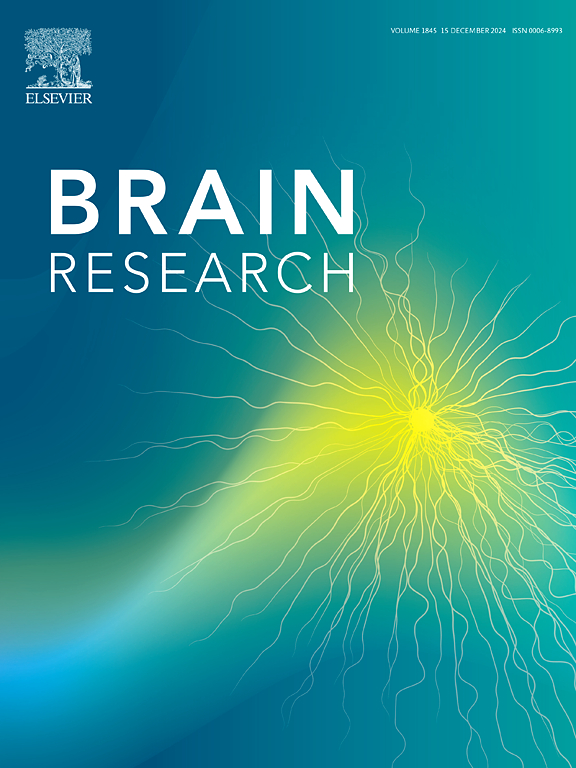间歇性θ波爆发刺激(iTBS)诱导n -乙酰天冬氨酸(NAAG)抑制缺血性脑卒中铁下垂的作用及机制研究
IF 2.6
4区 医学
Q3 NEUROSCIENCES
引用次数: 0
摘要
本研究探讨间歇性θ波爆发刺激(iTBS)通过诱导n -乙酰天冬氨酸(NAAG)抑制缺血性脑卒中铁下垂的机制。在大脑中动脉闭塞(MCAO)后的SD大鼠中,iTBS治疗通过增强突触功能和神经元修复,显著减轻脑缺血再灌注(I/R)损伤,改善运动、协调、空间记忆能力和认知功能障碍。Western blot分析显示,经iTBS处理的MCAO大鼠GPX4蛋白表达升高,ACSL4、TFRC、DMT1蛋白表达降低。此外,脂质过氧化产物丙二醛(MDA)显著降低。SOD和GSH抗氧化水平显著升高,铁离子含量降低。这些结果表明,iTBS通过减少氧化应激和铁积累有效地抑制铁下垂。代谢组学分析揭示了一项新的发现,iTBS增加NAAG水平并抑制其限制性酶FOLH1 (GCP-II),从而减少兴奋性谷氨酸产生,改善谷胱甘肽代谢,从而抑制铁凋亡。体外实验表明,NAAG和2-PMPA(一种FOLH1抑制剂)可改善氧-葡萄糖剥夺/再灌注(OGD/R)模型中的细胞存活和抗氧化能力,抑制铁凋亡。综上所述,iTBS通过调节NAAG的合成和代谢,增强抗氧化能力和铁代谢,延缓铁下沉,发挥神经保护作用。这项研究为中风后认知障碍的潜在治疗提供了新的见解。本文章由计算机程序翻译,如有差异,请以英文原文为准。
Study on the role and mechanism of intermittent theta burst stimulation (iTBS) induced N-acetylaspartylglutamate (NAAG) in suppressing ferroptosis in ischemic stroke
This study investigates the mechanism through which intermittent theta burst stimulation (iTBS) inhibits ferroptosis in ischemic stroke by inducing N-acetylaspartylglutamate (NAAG). In SD rats subjected to middle cerebral artery occlusion (MCAO), iTBS treatment significantly decreased ischemia–reperfusion (I/R) injury, improving motor, coordination, spatial memory abilities and Cognitive Impairment by enhancing synaptic function and neuronal repair. Western blot analysis showed that in MCAO rats treated with iTBS, GPX4 protein expression increased, while ACSL4, TFRC, and DMT1 protein levels decreased. Furthermore, malondialdehyde (MDA), a product of lipid peroxidation, was significantly reduced. The antioxidant levels of SOD and GSH were notably elevated, while the content of iron ions decreased. These results indicate that iTBS effectively inhibits ferroptosis by reducing oxidative stress and iron accumulation. Metabolomic analysis has revealed a novel finding that iTBS increases the levels of NAAG and inhibits its rate-limiting enzyme FOLH1 (GCP-II), thereby decreasing excitatory glutamate production, improving glutathione metabolism, and subsequently suppressing ferroptosis. In vitro experiments demonstrated that NAAG and 2-PMPA (a FOLH1 inhibitor) improved cell survival and antioxidant capacity in an oxygen-glucose deprivation/reperfusion (OGD/R) model, suppressing ferroptosis. In conclusion, iTBS exerts a neuroprotective effect by regulating the synthesis and metabolism of NAAG, enhancing antioxidant capacity and iron metabolism, and delaying ferroptosis. This research provides new insights into potential treatments for Post-Stroke Cognitive Impairment.
求助全文
通过发布文献求助,成功后即可免费获取论文全文。
去求助
来源期刊

Brain Research
医学-神经科学
CiteScore
5.90
自引率
3.40%
发文量
268
审稿时长
47 days
期刊介绍:
An international multidisciplinary journal devoted to fundamental research in the brain sciences.
Brain Research publishes papers reporting interdisciplinary investigations of nervous system structure and function that are of general interest to the international community of neuroscientists. As is evident from the journals name, its scope is broad, ranging from cellular and molecular studies through systems neuroscience, cognition and disease. Invited reviews are also published; suggestions for and inquiries about potential reviews are welcomed.
With the appearance of the final issue of the 2011 subscription, Vol. 67/1-2 (24 June 2011), Brain Research Reviews has ceased publication as a distinct journal separate from Brain Research. Review articles accepted for Brain Research are now published in that journal.
 求助内容:
求助内容: 应助结果提醒方式:
应助结果提醒方式:


